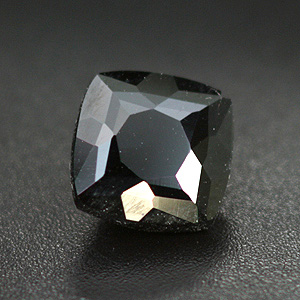Ilvaite

Ilvaite
(Square cut. From Elba, Italy. 2.30 carat; 7.3 x 7.3 x 4.6mm)
Image © supplied by Freakingcat Gems
The gemstones of Ilvaite are extremely rare and hence are not sold in the mainstream commercial gemstone market. Instead the Ilvaite gemstones are sold in niche markets and are purchased by gemstone collectors and experts who are ready to pay hundreds of dollars for a single carat of extremely clear and bright Ilvaite.
Ilvaite History & Etymology:
Ilvaite was first discovered on the island of Elba in 1811. Ilvaite in fact derives its name from the Latin name of the island of Elba, ilva. The Ilvaite mineral is fairly common occurrence in most rocks however finding crystals and gem stone quality crystals of Ilvaite is extremely difficult.
Ilvaite Occurrence:
The Ilvaite mineral is found in many localities across the world. It has been found in Elba, Italy, Greece, Russia and USA. However, not all these localities produce crystals of Ilvaite or gem quality crystals of Ilvaite. The island of Elba and Cyclades Islands in Greece have produced the largest crystals of Ilvaite which have been of the best gem quality. Ilvaite mined from the islands of Elba and Cyclades have been over 20 carats and commanded hundreds of dollars in price.
Ilvaite Properties:
Ilvaite is composed of calcium iron silicate hydroxide, which gives the Ilvaite crystals their characteristic black color. This coloring of the Ilvaite crystals makes them so popular with gemstone collectors who wish to include black gemstones in their gemstone collection at a fraction of the cost of black diamonds. The dominant silicon in Ilvaite classifies them as a silicate mineral. Ilvaite are related to the Lawsonite-Ilvaite Series.
Ilvaite occurs in orthorhombic and dipyramidal structures in their natural form. Ilvaite also occurs as prismatic crystals in column, spherical radiations and massive crystalline masses. These crystalline masses of Ilvaite are at least 25 cm in size. Ilvaite does not exhibit twinning. Ilvaite crystals display extremely distinct cleavages along with irregular fracturing which sometimes changes into uneven fracturing.
This distinct cleavages and uneven fracturing makes Ilvaite quite brittle despite the Moh’s hardness of the crystals being between 5.5 and 6. Ilvaite is relatively dense with a density of at least 4 g/cm3. Ilvaite however does not display properties of luminescence and is neither radioactive.
The calcium and iron binding with silicon and oxygen give Ilvaite its characteristic black coloring which has made the gemstones of Ilvaite hugely popular with gemstone collectors. The coloring of the Ilvaite gemstones also varies to grayish black depending on the oxidization. The transparency of the Ilvaite crystals is generally opaque and translucent edges can be seen of the Ilvaite crystals with distinct cleavage and minimum fracturing.
Ilvaite also exhibits a sub metallic luster with a refractive index between 1.7 and 1.8. Similarly, the birefringence index is 0.15, with Ilvaite displaying strong dispersion. Similarly the pleochroism and anisotrophism is also quite strong in the Ilvaite crystals.
Ilvaite is typically found in iron deposits and in metasomatic rocks with iron deposits. Ilvaite can also be found in calc-silicate minerals and in deposits of calc-silicate minerals in metamorphosed limestone, as well as in dolostones.
This well formed, tiny and shiny gemstone of Ilvaite is extremely sought after in the niche market and often considered the best in the black gem category for gemstone collectors.
Back to the Gemstones List home page - over 160 gemstones explored!
Please feel free to link to this page - copy / paste the text below: (click to select)
Privacy Policy | Cookie Policy | GDPR | About This Site / Terms

© gemstoneslist.com 2018


